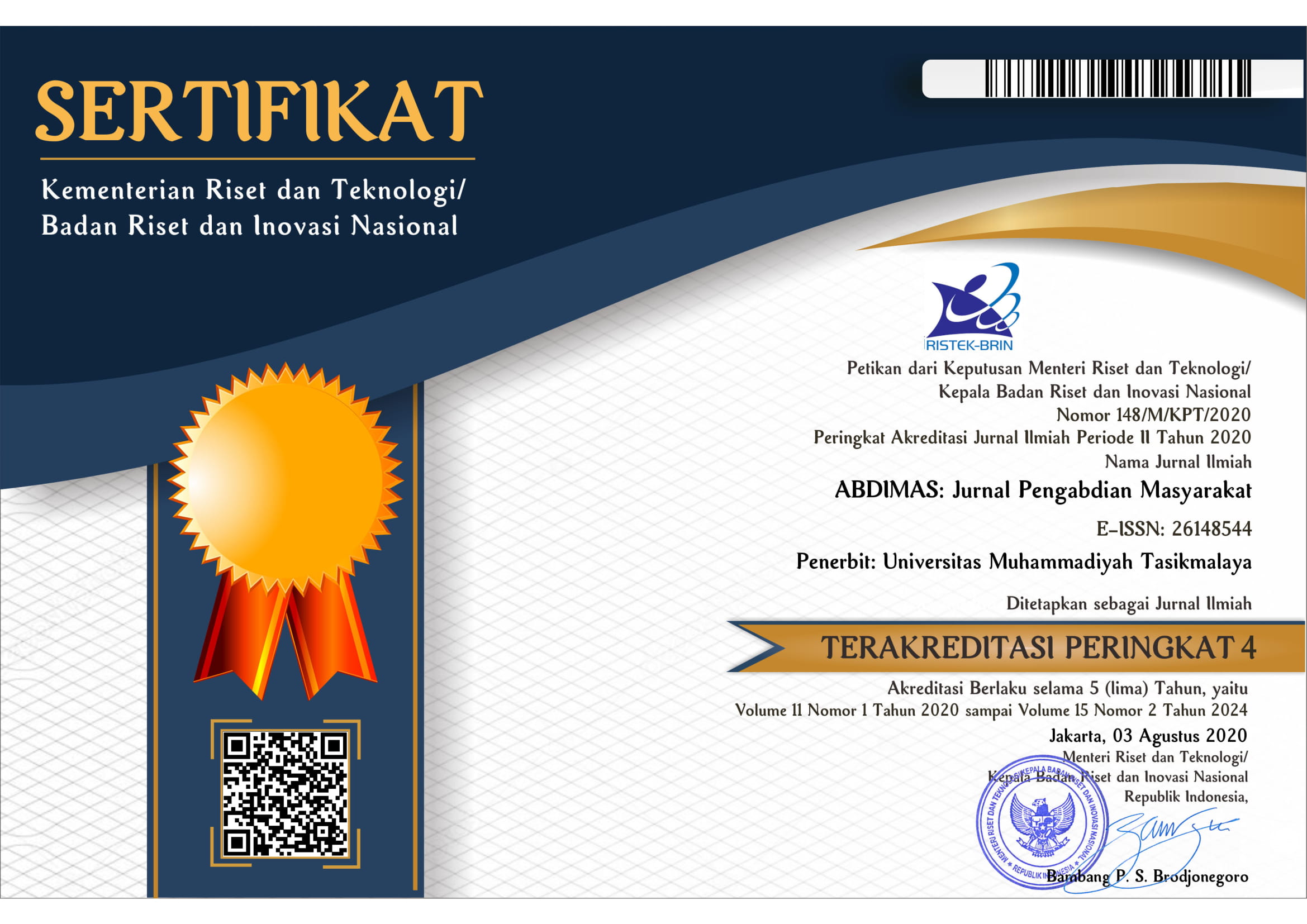Little Pharmacist Training and Healthy Nutritious Food Education for Elementary Students in Kemanisan Village
DOI:
https://doi.org/10.35568/abdimas.v6i2.3294Keywords:
Training, Little Pharmacist, DAGUSIBU, CBIAAbstract
WHO in its program, namely the Global School Health Initiative seeks to mobilize and strengthen health promotion and education activities in young children. One of the health education programs that could be held in elementary schools is the training of young pharmacists. Little Pharmacist, commonly abbreviated as Apocil, is an idea to introduce the role of the pharmacist profession more clearly from an early age. It is hoped that the presence of this little pharmacist in the future will increase elementary school students' awareness of medication and introduce the pharmacist profession to students and the community. Student and community knowledge regarding health and medicine is still limited. Medications have an important role in maintaining health, therefore it should be used correctly in order to provide optimal clinical benefits. The purpose of this community service is to train little pharmacists in an effort to use the right medicine and educate healthy, nutritious food for elementary school students in Kemanisan Village. The method used was the Active Individual Learning Method (CBIA), the practice of making powder medicine, and it was evaluated by carrying out DAGUSIBU (get, use, store, and dispose of) mini-games. The media used in this activity are banners, mortar and stamper, and parchment paper. From the results of the activities was found that the students had known the pharmacist role and understood DAGUSIBU as well as education on healthy nutritious food with good results using mini-games. In summary, it can be concluded that the provision of education can increase the knowledge of elementary school students in the village of Kemanisan.
Downloads
References
Ani Kristiyani, & Sarah Puspita Admaja. (2021). Edukasi Pengenalan Obat Kepada Siswa Sekolah Dasar. J.Abdimas: Community Health, 2(1), 28–34. https://doi.org/10.30590/jach.v2n1.p28-34.2021
Anonim. (2014). Undang Undang Republik Indonesia Nomor 36 Tahun 2014 tentang Tenaga Kesehatan (pp. 1–24).
Astuti, E. J., & Hidayati, I. R. (2021). EDUKASI DAGUSIBU DAN PENGENALAN APOTEKER CILIK (APOCIL). Jurnal Pengabdian Masyarakat, 4(3), 984–989. https://doi.org/10.31604/jpm.v4i3.984-989
Atmadani, R. N., & Hidayati, I. R. (2020). Pelatihan Apoteker Cilik dan DaGuSiBu bagi Siswa SDN Losari di Singosari, Kabupaten Malang. Jurnal Pengabdian UNDIKMA, 1(2), 77. https://doi.org/10.33394/jpu.v1i2.2966
Fahriati, A., Nurihardiyanti, Maelaningsih, F. S., Aulia, G., Sari, D. P., Werawati, A., Fadhilah, H., Ismaya, N. A., Melizsa, Nadya A R I, & Sayyidah. (2020). Penyuluhan dan Pengenalan Profesi Apoteker kepada Siswa Sekolah Dasar di MIN 2 Tangerang Selatan. Prosiding Senantias, 1(1), 687–694.
Harahap, N. A., Khairunnisa, & Tanuwijaya, J. (2017). Tingkat Pengetahuan Pasien dan Rasionalitas Swamedikasi di Tiga Apotek Kota Panyabungan. Jurnal Sains Farmasi & Klinis, 3(2), 186–192. https://media.neliti.com/media/publications/129397-ID-none.pdf
Hidayati, R., Rahmawaty, A., & Caesar, D. L. (2022). Cerdas Mengenal Obat Bersama Apoteker Cilik (Apocil) di SDN 1 Jepang Kudus. Muria Jurnal Layanan Masyarakat, 4(2), 132–136. https://doi.org/10.24176/mjlm.v4i2.8615
Lia Yunita, S., & Atmadani, R. N. (2021). IBM DaGuSiBu Obat dan Pemeriksaan Kesehatan Bagu Pekerja Migran (PMI) di Taipei, Taiwan. Selaparang, Jurnal Pengabdian Masyarakat Berkemajuan, 4(2), 205–209. https://media.neliti.com/media/publications/535054-none-d4b37761.pdf
Matson, K. L., Orr, K. K., Marino, C., & Cohen, L. (2019). The Effect of a Student Pharmacist Directed Health-Education Program for Elementary-School Children. INNOVATIONS in Pharmacy, 10(4), 6. https://doi.org/10.24926/iip.v10i4.1457
Peraturan Pemerintah. (2009). Peraturan Pemerintah no 51 tahun 2009 tentang Pekerjaan Kefarmasian.
Prakash, P., Kumar, S., Kumari, S., Sinha, P., & (2021). Knowledge and Perception of Drugs Use and Abuse among Secondary School Students. International Journal of Research and Review (Ijrrjournal.Com), 8, 3.
Ristian Octavia, D., & Aisyah, M. (2019). Pelatihan Apoteker Cilik Siswa Sekolah Dasar dalam Upaya Penggunaan Obat yang Tepat di Lamongan. 2(2), 1–10. https://doi.org/10.31764/jces.v2i2.1482
Syofyan, S., Dachriyanus, D., Masrul, M., & Rasyid, R. (2019). The knowledge and attitudes about the benefits, risks and use of medicine in aged primary students in Indonesia. Open Access Macedonian Journal of Medical Sciences, 7(11), 1860–1866. https://doi.org/10.3889/oamjms.2019.347
Wahyuningsih, S. (2021). Edukasi Apoteker Cilik Terkait Pengenalan Obat Kepada Siswa Kelas 5 SD Negeri Mangkura 1 Makassar. INDRA: Jurnal Pengabdian Kepada Masyarakat, 2(2), 58–61. https://doi.org/10.29303/indra.v2i2.132












